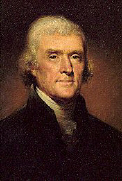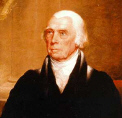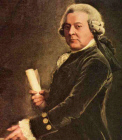Multiple
Choice
Identify the choice that best completes the statement or answers the
question.
|
|
|
Read the entire passage before you try to answer the questions
Background of Marbury v Madison
In 1800 the
government of the United States was still new. None of the branches, legislative-executive-judicial,
was sure of their authority. This was especially true of the Supreme Court. What authority did the
Supreme Court have? What cases could they rule on? Could they tell the other branches what to do?
Article III of the Constitution established the Supreme Court but it was not very specific about the
authority the court had.
The President of the United States has the power to appoint judges
to the federal courts. Usually, the President appoints individuals who are members of his own
political party or who share his ideas about politics.
In 1800, John Adams was President. Adams
was a Federalist who wanted a strong central government. There was an election that year. Thomas
Jefferson, who belonged to another political party, got elected. Jefferson was an anti-Federalist who
wanted the states to have more power. There were many positions in the federal government that were
empty. Before he left office, President Adams tried to fill these positions with people who shared
his ideas.
President Adams appointed 58 new people. He asked his Secretary of State, John
Marshall, to deliver the paperwork to these people so they could start their new jobs. Marshall
delivered most of the papers. He was in a hurry, so he left some of the papers for the new Secretary
of State, James Madison, to deliver. When he came into office, President Thomas Jefferson told
Madison not to deliver the papers to some of the people Adams had appointed.
One of the
individuals who didn't receive his papers was William Marbury. He sued James Madison and tried
to get the Supreme Court of the United States to issue a writ of mandamus. A writ is a
court order that forces an official to do something. Marbury argued that a law passed by Congress
(the Judiciary Act of 1789) gave the Supreme Court of the United States the power to issue this writ.
If the Court issued the writ, Madison would have to deliver the papers. Then Marbury would become a
justice of the peace. |

Thomas Jefferson

James Madison

John
Adams | | |
|
|
|
1.
|
Marbury based his argument on the Judiciary Act of 1789. What did he claim the
Act did?
a. | forced the President to make Federal court appointments | c. |
forced one
president to honor the acts of other presidents | b. |
gave the Supreme Court the power to issue writs
of mandamus | d. |
allowed the
Congress and the President to ignore the Supreme Court |
|
|
|
2.
|
What was the political philosophy of Thomas Jefferson
a. | Constitutionalist |
c. | Anti-Federalist | b. |
Federalist | d. |
Republican |
|
|
|
3.
|
What is a writ of mandamus?
a. | an order issued by the court requiring someone to do something | c. |
a requirement that
the police produce a writ of habeas corpus | b. |
an appointment to the court made by the
President | d. |
an oath taken by
all Federal employees to protect and defend the constitution |
|
|
|
4.
|
What was the political philosophy of John Adams?
a. | Federalist |
c. | Republican | b. |
Anti-Federalist | d. |
Democrat |
|
|
|
5.
|
Who tried to block the appointments of President Adams, who was leaving
office?
a. | James Madison |
c. | James Marbury | b. |
Justice Marshall | d. |
President Thomas
Jefferson |
|
|
|
6.
|
If the Supreme Court issued the writ of mandamus, Madison would be forced to
deliver the commission to Marbury.
a. | true |
c. | no way to tell from the reading | b. |
false |
|
|
|
7.
|
Why did Marbury sue James Madison?
a. | As Secretary of State Madison was supposed to deliver the paperwork to
Marbury | c. | Marbury was a Federalist | b. |
Madison was Secretary of State and an
Anti-Federalist | d. |
Marbury did
not like Madison |
|
|
|
8.
|
Under our political system, who has the power to appoint judges to the federal
courts.
a. | the House of Representatives | c. |
the President | b. |
the Supreme
Court | d. |
judges are elected
not appointed |
|
|
|
9.
|
What did William Marbury want the government to do.
a. | He wanted the Congress to force Jefferson to honor his appointment | c. |
He wanted the
Supreme Court to issue a writ of mandamus. | b. |
He wanted the Senate to force Jefferson to
honor his appointment |
d. |
He
wanted the Supreme Court to issue a writ of habeas corpus |
|
|
|
10.
|
An Act is a law passed by Congress.
a. | true |
c. | neither true nor false | b. |
false | d. |
both true and
false |
|
|
|
11.
|
What job was William Marbury trying to get with the government?
a. | Army Captain |
c. | Justice of the Peace (judge) | b. | Congressman |
d. | Senator |
|
|
|
The Supreme Court Ruling by John Marshall
The Supreme Court of the United
States had to decide the case. The new Chief Justice of the United States was John Marshall. He was
the same person who had been unable to deliver the paperwork in the first place!
The new chief
justice, John
Marshall, understood that if the Supreme Court issued a writ of mandamus (i.e., an order to force
Madison to deliver the commission), the Jefferson administration would ignore it, and thus
significantly weaken the authority of the courts. On the other hand, if the Court denied the writ, it
might well appear that the justices had acted out of fear. Either case would be a denial of the basic
principle of the supremacy of the law. Instead, Marshall found a common ground where the Court could
chastise (scold) the Jeffersonians for their actions while enhancing the Supreme Court's power.
His decision in this case has often been hailed as a judicial tour de force (a skillful decision
showing power).
Marshall’s Decision
1. Marshall declared that Madison should have
delivered the commission to Marbury.
2. Even though the Judiciary Act of 1789 (passed by Congress)
gave the Supreme Court the power to issue writs of mandamus, Marshall said the Judiciary Act was
wrong because it violated Article III of the Constitution
3. Because of the above two actions,
Marshall ruled that the Supreme Court did not have the authority to issue the write of
mandamus
So, while the case limited the court's power to issue writs in this case
because it violated the Constitution, it greatly enhanced the Supreme Courts authority to say what
was and what was not constitutional. From this point on the Supreme Court what have the authority to
say what was constitutional.
Just as important, it emphasized that the Constitution is the
supreme law of the land and that the Supreme Court is the arbiter and final authority of the
Constitution. As a result of this court ruling, the Supreme Court became an equal partner in the
government. | |
|
|
|
12.
|
If John Marshall issued a writ of mandamus, forcing Jefferson to deliver the
papers that allowed Marbury to become justice of peace, what would Jefferson do in answer to the
writ?
a. | resign from office | c. | most likely obey the writ (order) | b. | most likely ignore
the writ (order) | d. | most
likely fire John Marshall from the Supreme Court |
|
|
|
13.
|
If Jefferson obeyed the court order it would _____ the court, if Jefferson
ignored the court order it would _____ the court.
a. | strengthen - weaken | c. | do nothing to - have no effect on | b. | weaken -
strengthen |
|
|
|
14.
|
If the Supreme Court refused to issue the writ of mandamus it would
.......
a. | make the court look like it was not afraid of Jefferson or public
opinion | c. | allow Congress to outlaw the Supreme Court | b. | make the court look
like it was afraid of Jefferson | d. | allow the President to outlaw the Supreme Court |
|
|
|
15.
|
What basic principle was Justice Marshall most concerned with?
a. | That Marbury get his commission as Justice of the Peach | c. | That the
Jeffersonians be defeated | b. | That all branches of government, including the
Constitution be equal parts of the government. | d. | That the law (Constitution) be supreme over any
person, party or branch of government |
|
|
|
16.
|
How did the decisions of Justice Marshall make the Supreme Court
stronger.
a. | He established the principle that only the Supreme Court could say what was and what
was not constitutional | c. | He ruled that Marbury should get his commission | b. | He established the
principle that only the Congress could say what was and what was not
constitutional | d. | He ruled
that Jefferson had the right to withhold Marbury’s commission |
|
|
|
17.
|
What is an additional principle established by Justice John Marshall in the
Marbury v Madison case.
a. | The President was inferior to the Congress | c. | The Congress could pass laws (acts)
that superceded the Constitution | b. | The Congress was inferior to the
President | d. | The Constitution
is the supreme law of the United States |
|
|
|
18.
|
What is an additional principle established by Justice John Marshall in the
Marbury v Madison case?
a. | Congress has the right to pass laws that may contradict the
Constitution | c. | The President could refuse to enforce laws that he felt were
unconstitutional | b. | Only the Supreme Court can determine what laws are constitutional or
not | d. | That the Federalists
are right and the Anti-Federalists are wrong |
|
|
|
19.
|
In the 2000 elections there was a great deal of debate and many law suits about
the election outcome in Florida. Finally the Supreme Court ruled that both sides had to accept the
decisions of the State of Florida, giving George Bush the election. When the Supreme Court made its
ruling, both sides backed off and accepted the courts decision. Justice John Marshall’s ruling
in Marbury v Madison made this possible.
a. | This statement is true | c. | There is no way to tell if this statement is true or
false | b. | This statement is false |
|
|
|
20.
|
Ours is a government of laws, not men
a. | This statement is true | c. | This statement has no meaning | b. | This statement is
false | d. | There is no way to
tell if the statement is true or false |
|
|
|
21.
|
Which cases were involved with civil rights?
a. | c, d, e, | c. | a, b, c | b. | a, b, f | d. | d, e, f |
|
|
|
22.
|
Which cases were involved with the balance of power and authority of branches of
governmnt?
a. | c, d, e | c. | d, e, f | b. | a, b, c | d. | a, c, d |
|
Matching
|
|
|
a. | Marbury v. Madison | d. | Plessy v. Ferguson | b. | McCulloch v. Maryland | e. | Brown v. Board of Education
Topeka | c. | United States v. Nixon | f. | Miranda v. Arizona |
|
|
|
23.
|
Which case presented a constitutional crisis for the U.S. in the 1970’s
and established that one branch of government could not ignore the constitutional authority of
another branch.
|
|
|
24.
|
When the Constitution--the
nation's highest law--conflicts with an act of the legislature, that act is invalid. This case
establishes the Supreme Court's power of judicial review
|
|
|
25.
|
Which case was fought over this issue: defendants were questioned "while in custody or otherwise deprived of
[their] freedom in any significant way." The petitioner was questioned by police, made
oral admissions, and signed an inculpatory statement all without being notified of his right to
counsel.
|
|
|
26.
|
The case presented two
questions: Did Congress have the authority to establish the bank? Did the State law
unconstitutionally interfere with congressional powers?
|
|
|
27.
|
Which case made the following
decion: State law is within constitutional boundaries. The majority upheld state-imposed racial
segregation. The justices based their decision on the separate-but-equal doctrine, that separate
facilities for blacks and whites satisfied the Fourteenth Amendment so long as they were
equal.
|
|
|
28.
|
California says that truck drivers from Mexico must have California drivers
licenses. U.S. law under the NAFTA treaty, signed by President Clinton, says that they do not. If you
are a lawyer who has to argue for the U.S. and against California, what Supreme Course case
would you cite?
|
|
|
29.
|
Which case made this ruling:
Despite the equalization of the schools by "objective" factors, like class size and
buildings, intangible issues foster and maintain inequality. Racial segregation in public education
has a detrimental effect on minority children because it is interpreted as a sign of inferiority. The
long-held doctrine that separate facilities were permissible provided they were equal was
rejected.
|
|
|
30.
|
Congress passes a law outlawing abortion in the United States. In Roe v. Wade
the Supreme Court says the law passed by congress is unconstitutional. What case above gives the
Supreme Court the power to do this?
|
|
|
31.
|
Which case was fought over this issue: Is the President's right to safeguard certain information, using his
"executive privilege"
confidentiality power, entirely immune from judicial
review?
|
|
|
32.
|
In a unanimous decision, the
Court held that Congress had the power to incorporate the bank and that the State could not tax instruments of the national government employed in
the execution of constitutional powers.
|
|
|
33.
|
Which case involved this event:
The state of Louisiana enacted a law that required separate railway cars for blacks and whites. In
1892, an African American--who was seven-eighths Caucasian--took a seat in a "whites only"
car of a Louisiana train. He refused to move to the car reserved for blacks and was arrested.
|
|
|
34.
|
In what case did Justice Marshall establish the authority of the Supreme Court
as an equal branch of government?
|
|
|
35.
|
Does the police practice of
interrogating individuals without notifiying them of their right to counsel (lawyer) and their
protection against self-incrimination violate the Fifth Amendment?
|
|
|
36.
|
Congressional power supercedes state power
|
|
|
37.
|
The Court specifically outlined
the necessary aspects of police warnings to suspects, including warnings of the the right to remain
silent and the right to have counsel present during interrogations.
|
|
|
38.
|
Which case was decided on this
issue: Black children were denied admission to public schools attended by white children under laws
requiring or permitting segregation according to the races.
|
|
|
39.
|
Which case said the president is subject to “due process of law”
and the president must obey a subpoena
presented to him
|
|
|
40.
|
Is Louisiana's law
mandating racial segregation on its trains an unconstitutional infringement on both the privileges
and immunities and the equal protection clauses of the Fourteenth Amendment?
|
|
|
41.
|
Does the segregation of
children in public schools solely on the basis of race deprive the minority children of the equal
protection of the laws guaranteed by the 14th Amendment?
|
|
|
42.
|
Which case made the following
ruling: segregation does not in
itself constitute unlawful discrimination
|